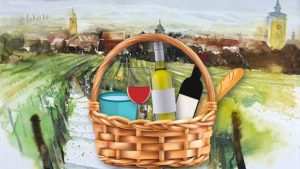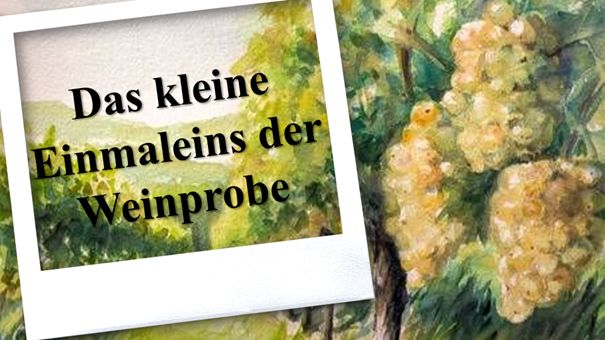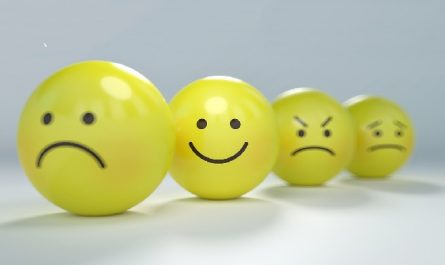*** See english version below ***
Das kleine Einmaleins der Weinprobe.
Heute zum Abschluss unserer Reise in die Kunst der Weinkultur schauen wir uns an, wie man eigentlich richtig an einer Weinprobe teilnimmt. Mein Opa hat jeden Herbst große Weinproben in Rheinhessen gehalten und geführt. Er wurde von den Winzern eingeladen, die Weine zu probieren und sein alles entscheidendes Urteil abzugeben. Ich erinnere mich immer an einen kurzen Moment der Stille in der, der Atem angehalten wurde, bevor Opa den Wein für gut befunden hat und der Winzer erleichtert ausatmete. Die feine Nase und den Gaumen, den es braucht, um an einer Weinprobe teilzunehmen, gar sie zu führen verlangt jahrelanges „Training“ und Feingefühl für die Kunst des Weinkelterns.
Also bist du ein Amateur oder ein Professional? – Finde es heraus mit der Hilfe von Maria.

Maria, hat in den letzten Wochen viel über Wein gelernt. Sie hat verschiedene Weinregionen in Europa besucht und sich durch die unterschiedlichsten Sorten probiert.
Allerdings ist ihr immer wieder aufgefallen, dass sie eigentlich gar nicht weiß, wie man richtig Wein probiert und ist somit des Öfteren Abends etwas beschwipst ins Bett gefallen. Geht es dir auch so?
Damit Maria und dir, dass nicht mehr passiert und ihr euch auf der nächsten Weinprobe nicht mehr blamiert, kommt hier das kleine Ein mal Eins der Weinprobe.
Zuerst brauchst du die Essentials:
- Einen Eimer
- Etwas Brot und Käse gegen den kleinen Hunger zwischendurch
- Gläser: !!! Aber Achtung je nach Weinsorte gibt es unterschiedliche Arten von Gläsern, die man verwendet
- Und selbstverständlich Wein

Nachdem wir alles zusammen haben, suchen wir uns ein ruhiges Plätzchen und lassen die Experten ans Werk. Idealerweise fragt man direkt bei einem Winzer an, ob man zu einer entweder privaten Weinprobe vorbeikommen kann oder wann es das nächste Winzerfest gibt, dass man besuchen könnte.
Heute probieren wir einen Weißwein. Ein kleiner Schluck ins Glas. Und dann avinieren wir das Glas, dass bedeutet, dass wir mit dem kleinen Schluck Wein das Glas vorspülen um Reste von Spülmittel, Staub oder Gerüchen zu befreien. Man schwenkt den Wein also einmal kurz im Glas. Wenn du mehrere Gläser hast, schütte den Rest einfach ins nächste Glas und wiederhole den Vorgang.
Und jetzt kann es richtig losgehen. Schenke dir etwas weniger als ein viertel ins Glas, grade wenn du vor hast mehrere Weine zu probieren und nicht schief ins Bett taumeln willst. Da wir heute Weißwein probieren achte darauf, dass die Temperatur des Weines bei 9-10°C liegt, damit sich der Geschmack des Weines voll entfalten kann. Dabei hilft es das Glas am Stiel oder am Fuss des Glases anzufassen, damit so wenig Körperwärme wie möglich an den Wein kommt.
Erste Eindrücke über das Alter des Weines lässt sich meist schon an der Farbe erkennen. Weißweine erscheinen im Glas grünlich gelb bis golden. Man sagt je grünlicher der Wein desto jünger ist er. Allerdings ist das je nach Sorte eine sehr vage Aussage. Andererseits sind goldgelbe Weine meist reichhaltiger und süßer im Aroma.
Nachdem der Wein nun kurz im Glas atmen konnte, wird der Geruch des Weines genauer unter die Lupe genommen. Dieser gibt viel Aufschluss über die Qualität eines Weines. Durch den Geruch können Substanzen wahrgenommen werden, die beim eigentlichen Probieren verloren gehen. Somit sollte man diesen Schritt und seine Bedeutung bei einer Weinprobe nicht unterschätzen. Lass dir also Zeit beim riechen und du wirst überrascht sein, was dir der Wein bereits alles über sich erzählt.

Und jetzt kannst du endlich einen Schluck nehmen, aber nicht direkt runterschlucken! Du wirst merken, dass der Profi zwar einen großen Schluck nimmt, ihn aber nur im Mund behält, um den Mundraum mit dem Wein zu benetzen und ihn dann in einen Eimer oder ein Gefäß zu spucken. Dieser erste Berührungspunkt im Mund, verrät dir welchen Säuregehalt der Wein hat. Beim nächsten Schluck nimmt man dann die Fülle oder auch das Volumen des Weines wahr. Wenn er deinen gesamten Mundraum ausfüllt, spricht man von einem großen Volumen.
In der zweiten Runde des Probierens, solltest du wieder erst mit dem Riechen anfangen. Das Glas einmal kurz schwenken, denn der Wein konnte bereits einige Zeit an der Luft ziehen, so mischen sich die Aromen neu. Schmeckst du neue Aromen aus dem Wein? Durch diese zweite Runde kann man noch Mal viel neues im Wein erkennen. Auch das einziehen von Luft während du den Wein im Mund hast, was man oft als schlürfen wahrnimmt hilft, dass sich das Aroma am Gaumen voll entfalten kann. Du wirst merken, wenn du mit deinen Freunden oder deiner Familie eine Weinprobe besuchst, dass jeder den Wein anders wahrnehmen wird, dass liegt daran, dass die Geschmackssensoren bei jedem anders ausgeprägt sind.

Wenn du fertig probiert hast, nimm dir gerne ein Stückchen Brot, schließlich wollen wir nicht, dass du dich wie ein Amateur anstellst und nach Hause getragen werden musst. Auch Opa hat das mal mehr und mal weniger eingehalten. Klar war immer eine Weinprobe wurde zelebriert und es gab nichts und niemand, dass ihn da aus der Ruhe bringen konnte. Wein war sein Element und jeden Schluck Wein den ich heute probiere, probiere ich in Gedanken mit ihm zusammen.
*** English version ***
Today, to conclude our journey into the art of viticulture, we look at how to actually properly participate in a wine tasting. My grandpa held and led large wine tastings in Rheinhessen every fall. He was invited by the winemakers to taste the wines and give his all-important verdict. I always remember a brief moment of silence in which, the breath was held before grandpa approved the wine and the winemaker exhaled with relief. The fine nose and palate it takes to participate in a wine tasting, even to lead it requires years of “training” and sensitivity to the art of wine making.
So, are you an amateur or a professional? – Find out with the help of Maria.

Maria, has learned a lot about wine in the last few weeks. She has visited various wine regions in Europe and tasted her way through many different varieties. However, she has always noticed that she doesn’t know how to taste wine properly and has often fallen into bed tipsy in the evening. Do you feel the same way?
So that this doen’t happen to Maria and you again and you do not embarrass yourselves at the next wine tasting, here comes the small one time one of wine tasting.
First, you’ll need the essentials:
- A bucket
- Some bread and cheese against the little hunger in between
- Glasses: !!! But beware depending on the type of wine there are different types of glasses you use
- And of course, wine

After we have everything together, we look for a quiet place and let the experts to work. Ideally, you ask directly to a winemaker if you can come over for either a private wine tasting or when there is the next wine festival that you could visit.
Today we try a white wine. A small sip into the glass. And then we avinate the glass, which means that we pre-rinse the glass with the small sip of wine to remove residues of detergent, dust, or odours. So, you swirl the wine once briefly in the glass. If you have several glasses, just pour the rest into the next glass, and repeat the process.
And now you’re ready to get started. Pour a little less than a quarter in the glass, especially if you plan to taste several wines and do not want to stagger into bed crooked. Since we are tasting white wine today, make sure that the temperature of the wine is at 9-10°C, so that the taste of the wine can fully develop. It helps to hold the glass by the stem or the foot of the glass so that as little body heat as possible gets to the wine.
First impressions about the age of the wine can usually already be recognized by the colour. White wines appear greenish yellow to golden in the glass. It is said that the greener the wine, the younger it is. However, depending on the variety, this is a very vague statement. On the other hand, golden wines are usually richer and sweeter in flavour.
After the wine has been allowed to breathe in the glass for a short time, the smell of the wine is examined more closely. This gives a lot of information about the quality of a wine. Through the smell, substances can be perceived that are lost in the actual tasting. Thus, one should not underestimate this step and its importance in a wine tasting. So, take your time smelling and you will be surprised what the wine already tells you about itself.

And now you can finally take a sip, but don’t swallow it right away! You’ll notice that the professional will take a big gulp but will only keep it in his mouth to wet the roof of his mouth with the wine and then spit it into a bucket or container. This first point of contact in the mouth, tells you what acidity the wine has. With the next sip, you then perceive the fullness or even the volume of the wine. If it fills your entire mouth, it is called a great volume.
In the second round of tasting, you should start smelling again first. Swirl the glass once, because the wine has already had some time to breathe, so the aromas mix again. Do you taste new aromas from the wine? Through this second round, you can once again detect a lot of new things in the wine. Also, drawing in air while you have the wine in your mouth, which is often perceived as slurping, helps the flavour to fully develop on the palate. You will notice when you go wine tasting with your friends or family that everyone will perceive the wine differently, this is because everyone’s taste sensors are different.

When you’re done tasting, feel free to take a piece of bread, after all, we don’t want you to act like an amateur and must be carried home. Grandpa has also adhered to this sometimes more and sometimes less. It was always clear that a wine tasting was celebrated and there was nothing and no one that could disturb him. Wine was his element and every sip of wine I taste today, I taste in my mind together with him.
_______________________________________________________________________
Have you seen my latest posts?
Welcome to a deep dive into the finest wines
A sweet tasty journey to Rheinhessen, the cradle of European viticulture
A treasure of liquid gold found in Alsace
A day in the vineyrads of Rheinhessen
Wo findet man flüssiges Gold? – Where to find liquid gold?
Auf den Spuren der Weine im Wallis – On the tracks of the wines in Valais
Auf ein letztes Glas Wein im Wallis – To a last glass of wine in Valais
_______________________________________________________________________
Sources


![Bronze doit of the Dutch East India Company (VOC), depicting its date of production and the Company's monogram logo. The VOC's logo was possibly in fact the first globally recognized corporate logo.[1]](https://blog.hslu.ch/majorobm/files/2019/03/Münze_Niederländische_Ostindien_Companie-320x265.jpg)
